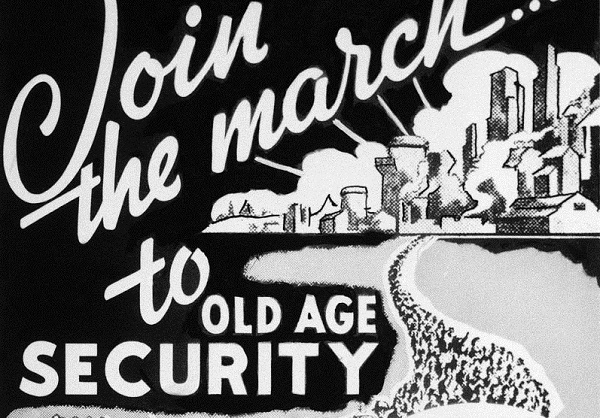 The bill increases benefits for allworkers by about 2 percent, on average. (Photo of old SocialSecurity poster: AP)
The bill increases benefits for allworkers by about 2 percent, on average. (Photo of old SocialSecurity poster: AP)
New Congressional Budget Office analysis of the Social Security 2100 Act shows the bill woulddelay, but not avoid, exhaustion of the two trusts that fundscheduled benefits to retirees and disabled Americans.
|Under existing law, CBO projects Social Security's primary OASDI trust fund willbe depleted in 2032, leading to a 24 percent reduction in benefitsfor all retirees in 2033.
|Under the Social Security 2100 Act, the primary trust fund wouldsurvive until 2041, after which retirees would see a 5 percentreduction in benefits.
|The analysis comes as Democrats in the House of Representativesare considering marking up the bill in the House Ways and MeansCommittee by Thanksgiving, according to reporting in the WallStreet Journal.
|The bill, sponsored by Rep. John Larson, D-CT, chair of the Waysand Means Social Security Subcommittee, has 210 co-sponsors in theHouse, all of whom are Democrats.
|CBO's analysis came at the request of Rep. Kevin Brady, R-TX,ranking member on the Ways and Means Committee. During a committeehearing earlier this year, minority Republicans insisted a bill toreform Social Security be bipartisan, as has traditionally been thecase with reforms to the largest spending program within thefederal government.
|The bill increases benefits for all workers by about 2 percent,on average. "The percentage increases would be largest forbeneficiaries with lower lifetime earnings and smallest forbeneficiaries with higher lifetime earnings," according to CBO.
|It also establishes a new minimum benefit at 125 percent of the2019 federal poverty line. A beneficiary who had worked 30 yearswould be entitled to the new minimum of $15,610.50. The new minimumwould be indexed annually to wage increases. About 12 percent ofnew beneficiaries in 2020 would be entitled to the new minimum.
|To pay for the increased benefits, Rep. Larson's bill lifts theexisting payroll tax wage base of $132,900 to $400,000.
|And it increases the existing payroll tax for all workers fromtoday's 12.4 percent to 14.8 percent by 2041. The rate hike wouldbe graduated, beginning with a 0.1 percent annual increase startingin 2020.
|If implemented alone, the new payroll tax rate "would increasethe tax burden of lower-income workers by a larger percentage thanthat for higher-income workers," CBO says.
|But when also incorporating the increased tax base to $400,000,CBO estimates the increase in tax burden would be largest for thewealthiest wage earners.
|The bill has been rubberstamped by the Social SecurityAdministration as making the program actuarially sound over thelong run.
|But the new analysis from CBO calls that determination intoquestion.
|"Social Security's chief actuary says Rep. Larson's bill gets usto solvency, but CBO says it doesn't get us there," explained MarcGoldwein, senior vice president for the Committee for a ResponsibleFederal Budget.
|The agencies' differing interpretations are explained, in part,by CBO's larger budgetary analysis.
|Specifically, CBO shows Rep. Larson's plan would increaseon-budget deficits by "hundreds of billions of dollars in eachdecade" in the long run because reduced income taxes on SocialSecurity benefits would no longer be allocated to Medicare'sHospital Insurance trust fund.
|CBO also says the across-the-board increase in payroll taxeswould result in lower income tax revenues.
|"These are fixable problems, but the legislation needs changes,"said Goldwein. "CBO thinks there is more that has to be done toachieve solvency." That will make it more difficult to push thelegislation through Committee, he said.
|Rep. Larson's bill would reduce Social Security's 75-yearactuarial deficit from 1.5 percent of GDP to 0.1 percent, CBOsays.
|And after 75 years, it would shrink the annual gap between theprogram's revenues and its costs. But that gap would thereafterincrease, indicating future shortfalls after the 75-year period,CBO said.
|READ MORE:
Complete your profile to continue reading and get FREE access to BenefitsPRO, part of your ALM digital membership.
Your access to unlimited BenefitsPRO content isn’t changing.
Once you are an ALM digital member, you’ll receive:
- Critical BenefitsPRO information including cutting edge post-reform success strategies, access to educational webcasts and videos, resources from industry leaders, and informative Newsletters.
- Exclusive discounts on ALM, BenefitsPRO magazine and BenefitsPRO.com events
- Access to other award-winning ALM websites including ThinkAdvisor.com and Law.com
Already have an account? Sign In






